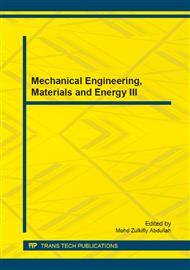[1]
Bedekar S V, Nithiarasu P, Seetharamu K N. Experimental investigation of the performance of a counter-flow, packed-bed mechanical cooling tower[J]. Energy, 1998, 23(11): 943-947.
DOI: 10.1016/s0360-5442(98)00044-9
Google Scholar
[2]
Williamson N, Armfield S, Behnia M. Numerical simulation of flow in a natural draft wet cooling tower–The effect of radial thermofluid fields[J]. Applied Thermal Engineering, 2008, 28(2): 178-189.
DOI: 10.1016/j.applthermaleng.2007.03.036
Google Scholar
[3]
Lemouari M, Boumaza M, Mujtaba I M. Thermal performances investigation of a wet cooling tower[J]. Applied thermal engineering, 2007, 27(5): 902-909.
DOI: 10.1016/j.applthermaleng.2006.08.014
Google Scholar
[4]
Kloppers J C, Kröger D G. The Lewis factor and its influence on the performance prediction of wet-cooling towers[J]. International Journal of Thermal Sciences, 2005, 44(9): 879-884.
DOI: 10.1016/j.ijthermalsci.2005.03.006
Google Scholar
[5]
Facao J, Oliveira A C. Thermal behaviour of closed wet cooling towers for use with chilled ceilings[J]. Applied Thermal Engineering, 2000, 20(13): 1225-1236.
DOI: 10.1016/s1359-4311(99)00096-4
Google Scholar
[6]
Stevens D I, Braun J E, Klein S A. An effectiveness model of liquid-desiccant system heat/mass exchangers[J]. Solar Energy, 1989, 42(6): 449-455.
DOI: 10.1016/0038-092x(89)90045-5
Google Scholar
[7]
Khan J U R, Yaqub M, Zubair S M. Performance characteristics of counter flow wet cooling towers[J]. energy conversion and management, 2003, 44(13): 2073-(2091).
DOI: 10.1016/s0196-8904(02)00231-5
Google Scholar
[8]
El-Dessouky H T A, Al-Haddad A, Al-Juwayhel F. A modified analysis of counter flow wet cooling towers[J]. Journal of heat transfer, 1997, 119(3): 617-626.
DOI: 10.1115/1.2824150
Google Scholar
[9]
Naphon P. Study on the heat transfer characteristics of an evaporative cooling tower[J]. International communications in heat and mass transfer, 2005, 32(8): 1066-1074.
DOI: 10.1016/j.icheatmasstransfer.2005.05.016
Google Scholar
[10]
Dreyer A A, Erens P J. Modelling of cooling tower splash pack[J]. International journal of heat and mass transfer, 1996, 39(1): 109-123.
DOI: 10.1016/s0017-9310(96)85010-1
Google Scholar
[11]
Baker D, Baker D R. Cooling tower performance[M]. Chemical Publishing, (1984).
Google Scholar
[12]
Benton D J, Bowman C F, Hydeman M, et al. An improved cooling tower algorithm for the CoolToolsTM simulation model[J]. ASHRAE Transactions, 2002, 108(1): 760-768.
Google Scholar
[13]
Olander D. Design of direct contact cooler-condensers[J]. Industrial & Engineering Chemistry, 1961, 53(2): 121-126.
DOI: 10.1021/ie50614a025
Google Scholar
[14]
Lebrun J, Silva C A, Trebilcock F, et al. Simplified models for direct and indirect contact cooling towers and evaporative condensers[J]. Building Services Engineering Research and Technology, 2004, 25(1): 25-31.
DOI: 10.1191/0143624404bt088oa
Google Scholar


